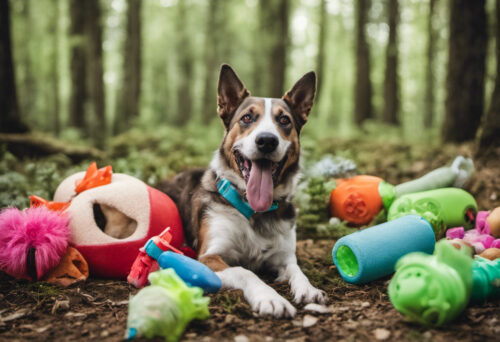Earth is our home, and it’s not just a human one. It’s home to millions of species, including our four-legged friends. But, just like us, our dogs also contribute to the carbon footprint (or carbon pawprint, if you will). Don’t get your tail in a knot, though. We’ve got some tips to help reduce the environmental impact of your furry pal. After all, every small step can lead to a big leap towards sustainability.
Scoop that Poop: Eco-Friendly Style
Every dog owner knows the drill: walk, poop, scoop, toss. It’s a necessary routine, both for our sanity and city regulations. But have you ever thought about where all those plastic poop bags end up? Most find their way into landfills where, because they’re made of plastic, they can take hundreds to thousands of years to decompose. Not exactly the most eco-friendly option.
That’s where biodegradable poop bags come in. Made from plant-based materials like cornstarch or wheat, these bags decompose in just a few months to a couple of years. The bags are just as durable and leak-proof as their plastic counterparts, but without the long-lasting environmental impact.
But wait! Don’t just grab the first “biodegradable” bag you see. Some bags labeled as such are misleading and still contain non-degradable materials. Look for bags labeled “compostable” or those that have a certification from a third-party like the BPI (Biodegradable Products Institute). This ensures that they’ll break down as promised.
Decomposing Those Bags
Additionally, consider the end-of-life of these bags. While they are designed to break down, this often requires specific conditions like those found in industrial composting facilities. Home compost heaps usually don’t reach the temperatures needed to break down these bags, and if you’re disposing of them in a regular trash bin, they might still end up in a landfill without the right conditions to degrade. Therefore, if your city has a composting program that accepts pet waste, that’s the best place for these bags.
Switching to biodegradable bags is a small change to your routine, but it’s one that Mother Nature will surely appreciate. So next time your doggo does his business, remember – scoop that poop, but do it eco-friendly style!
Mindful Munching: Sustainable Diets
We all want our dogs to have the best, and that includes their diet. Meaty meals are often a favorite for our furry friends, but the environmental impact of producing those meals can be quite significant. A 2017 study by Gregory Okin at UCLA found that if American pets were their own country, they would rank fifth in global meat consumption. This not only contributes to greenhouse gas emissions, but also depletes other resources like water and land.
Now, don’t let this put you off feeding Fido. The trick lies in mindful munching. A diet that includes a mix of sustainably sourced proteins, plant-based foods, and balanced nutrients can drastically reduce that carbon pawprint. And before you raise your eyebrows – yes, dogs can safely enjoy many types of vegetables and grains. In fact, they can provide important nutrients and fiber to your dog’s diet.
Eco Alternatives
Think about incorporating foods like sweet potatoes, quinoa, peas, and carrots into Rover’s meals. You can mix these in with meat-based foods or use them as the base for homemade dog treats. Always remember to introduce new foods slowly and observe for any changes in your dog’s behavior or digestion.
When it comes to the protein part of the diet, consider options like locally-sourced meats or those from animals raised on sustainable farms. Alternatively, some dog food brands are now using novel proteins like insects or lab-grown meats that have a lower environmental impact.
Before making any major changes to your dog’s diet, always consult with a vet or a pet nutrition expert. They can help you understand your dog’s specific dietary needs and guide you towards a balanced, eco-friendly diet plan.
Feeding your dog doesn’t have to be a burden on the environment. With mindful munching, your pup can enjoy a varied, balanced diet that not only keeps them happy and healthy but also contributes to the well-being of our planet.
Toy Story: Opt for Sustainable Play
Dogs love to play, and toys are an essential part of their playtime. But, while your pup may be oblivious to the environmental impact of his favorite chew toy, you don’t have to be. Many conventional dog toys are made from plastics or synthetic fibers, which aren’t biodegradable and can pile up in landfills once your furry friend has had his way with them.
Here’s a bright idea: opt for sustainable play options. These are toys made from natural, recycled, or sustainably sourced materials. They can be just as entertaining for your pooch, without the additional environmental guilt.
Let’s start with materials. Consider toys made from natural rubber, hemp, or organic cotton. These materials are not only safer for the environment but also for your dog. Natural rubber is durable and safe to chew, while hemp and organic cotton toys can be perfect for light chewers.
Recycled Toys?
Another option is toys made from recycled materials. Some companies are getting innovative, repurposing used materials into new toys. For example, some brands make toys from recycled fire hoses or t-shirts, creating durable playthings while keeping unnecessary waste out of landfills.
Look for toys that have been sustainably produced. This means the production process also takes into account environmental impact, including factors like resource use, manufacturing process, and waste production. A product bearing a certification like the Global Organic Textile Standard (GOTS) can give you confidence that the toy has been made with environmental and social responsibility in mind.
Also, consider the toy’s life cycle. A sturdy, long-lasting toy may have a smaller environmental footprint than cheap ones that need to be replaced frequently.
When you switch to sustainable toys, you’re not just making a greener choice but also setting an example for your pup. After all, our dogs learn from us. By showing them the way, we’re ensuring they grow into eco-friendly companions, too.
Groom Green: Eco-Friendly Care
Grooming is an essential part of keeping your pup clean, healthy, and happy. But have you ever considered the environmental footprint of your dog’s grooming routine? Many traditional pet care products, from shampoos to tick treatments, contain harmful chemicals that can pose a risk to both your pet and the environment.
However, there’s no need to get your fur in a bunch – there are ways to groom green! Here’s how you can give your dog a spa day that Mother Nature would approve of.
First off, consider the products you’re using. Many commercially available dog shampoos and conditioners contain synthetic chemicals like parabens, sulfates, and phthalates, which can harm aquatic life when they get washed down the drain. Instead, opt for natural, biodegradable grooming products. These products use plant-based ingredients and avoid harmful additives, making them safer for your pup and the planet.
The Eco Way to Bathe Your Dog
Also, consider how often you’re bathing your dog. Dogs don’t need baths as frequently as humans do – in fact, too many baths can strip their skin of essential oils and lead to dry, itchy skin. Depending on your dog’s breed and lifestyle, they might only need a bath every few weeks to a few months. By bathing less frequently, you’ll not only help your dog’s skin stay healthy but also conserve water.
Next up, pest treatments. Conventional flea and tick treatments can contain pesticides that can harm beneficial insects and pollute waterways. As an alternative, consider natural pest prevention methods like essential oils, diet supplements, or pest-repellent plants. Remember, always consult your vet before making changes to your dog’s pest prevention routine to ensure their safety and efficacy.
And don’t forget about grooming tools. Opt for brushes and combs made from sustainable materials like bamboo or recycled plastic.
By choosing to groom green, you’re taking a stand for a healthier pet and a healthier planet. With a bit of knowledge and the right products, eco-friendly pet care can become a seamless part of your routine.

Walk More, Drive Less
Nothing beats the excitement in a dog’s eyes when they hear the word “walk.” It’s not only an opportunity for exercise but also a chance to explore their neighborhood, meet other dogs, and bond with their favorite human. But did you know walking could also help reduce your dog’s carbon pawprint? Here’s how.
It’s no secret that cars contribute to air pollution and climate change. Even a short trip to the local dog park can add up over time. Walking, on the other hand, has zero emissions. Plus, it’s free!
Next time you’re tempted to hop in the car for a quick trip to the park, consider lacing up your walking shoes instead. It might take a bit longer, but the benefits far outweigh the time spent. Not only are you reducing your carbon emissions, but you’re also giving your dog (and yourself) a good dose of exercise.
Letting Your Pup Engage With the Outdoors
Walking also allows your dog to engage with their environment in a way that car rides don’t. They can sniff, explore, and interact with their surroundings, providing mental stimulation alongside the physical exercise.
If walking to your destination isn’t possible, consider other low-impact options. If your city has pet-friendly public transportation, this can be a fun and eco-friendly adventure for your dog. Alternatively, carpooling with other pet owners can reduce the number of cars on the road.
And remember, it’s not just about the destination, it’s about the journey. Incorporating longer, more frequent walks into your routine can make a significant impact on reducing your pup’s carbon pawprint. Not only is it great for the planet, but it’ll likely lead to a happier, healthier pooch.
So, next time you reach for the car keys, think twice. Instead, grab the leash, hit the pavement, and enjoy the simple pleasure of a walk with your best friend.
Every Pawprint Counts
You don’t need to make dramatic changes to make a difference. Small steps, like switching to biodegradable poop bags or walking instead of driving to the park, can have a big impact over time. Remember, reducing our dogs’ carbon pawprint isn’t just about our furry friends—it’s about ensuring a healthier planet for all creatures, big and small.
In the words of animal welfare activist, Ricky Gervais, “Animals don’t have a voice. But I do. A loud one. A big mouth. My voice is for them. And I’ll never shut up while they suffer.” So, let’s use our voices, and our actions, to make paw-sitive changes for all.



